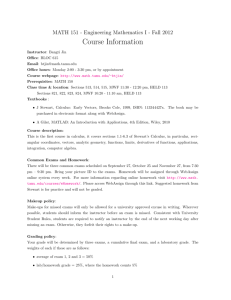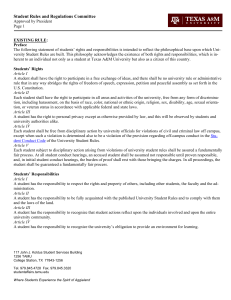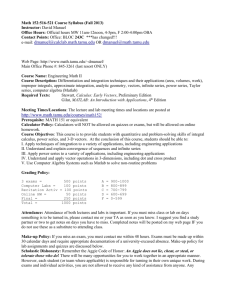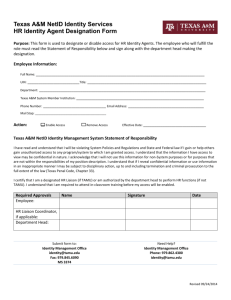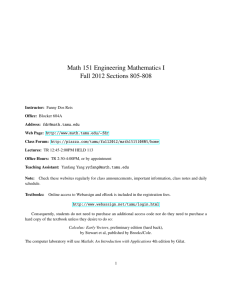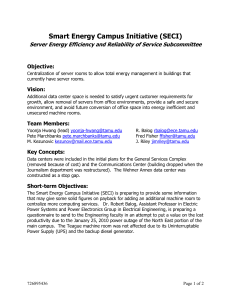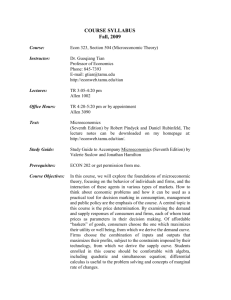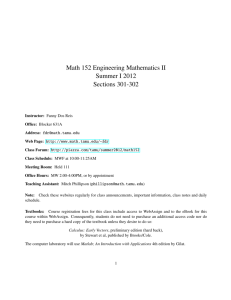Course Syllabus Math 151: Engineering Math I Fall Semester 2014
advertisement
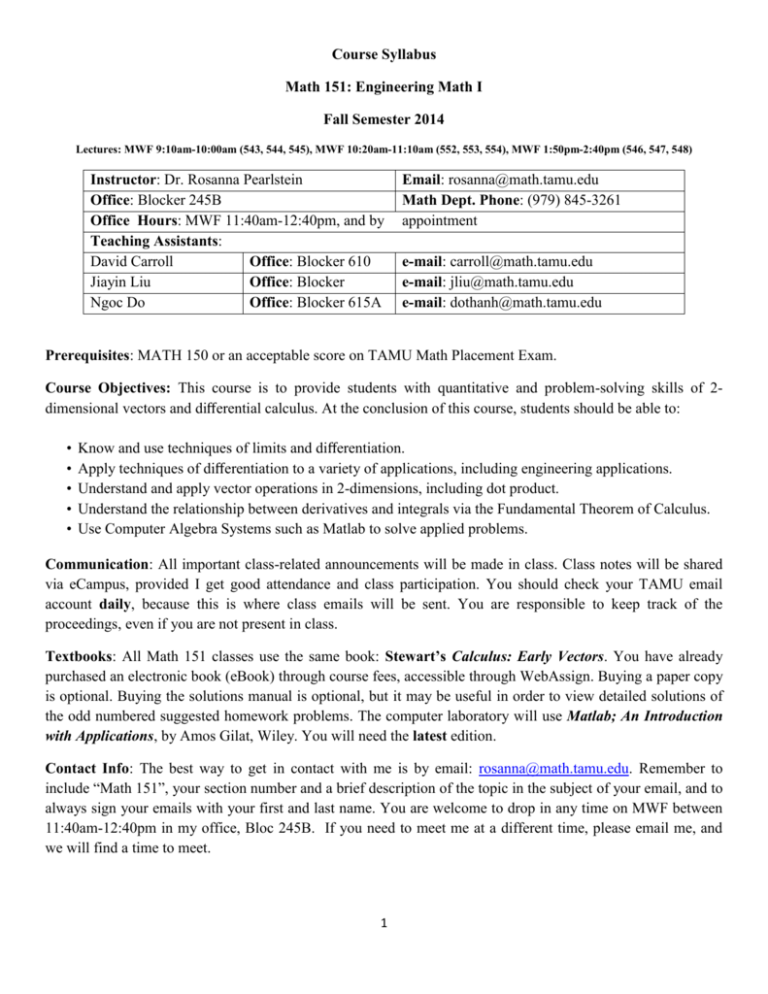
Course Syllabus Math 151: Engineering Math I Fall Semester 2014 Lectures: MWF 9:10am-10:00am (543, 544, 545), MWF 10:20am-11:10am (552, 553, 554), MWF 1:50pm-2:40pm (546, 547, 548) Instructor: Dr. Rosanna Pearlstein Office: Blocker 245B Office Hours: MWF 11:40am-12:40pm, and by Teaching Assistants: David Carroll Office: Blocker 610 Jiayin Liu Office: Blocker Office: Blocker 615A Ngoc Do Email: rosanna@math.tamu.edu Math Dept. Phone: (979) 845-3261 appointment e-mail: carroll@math.tamu.edu e-mail: jliu@math.tamu.edu e-mail: dothanh@math.tamu.edu Prerequisites: MATH 150 or an acceptable score on TAMU Math Placement Exam. Course Objectives: This course is to provide students with quantitative and problem-solving skills of 2dimensional vectors and differential calculus. At the conclusion of this course, students should be able to: • • • • • Know and use techniques of limits and differentiation. Apply techniques of differentiation to a variety of applications, including engineering applications. Understand and apply vector operations in 2-dimensions, including dot product. Understand the relationship between derivatives and integrals via the Fundamental Theorem of Calculus. Use Computer Algebra Systems such as Matlab to solve applied problems. Communication: All important class-related announcements will be made in class. Class notes will be shared via eCampus, provided I get good attendance and class participation. You should check your TAMU email account daily, because this is where class emails will be sent. You are responsible to keep track of the proceedings, even if you are not present in class. Textbooks: All Math 151 classes use the same book: Stewart’s Calculus: Early Vectors. You have already purchased an electronic book (eBook) through course fees, accessible through WebAssign. Buying a paper copy is optional. Buying the solutions manual is optional, but it may be useful in order to view detailed solutions of the odd numbered suggested homework problems. The computer laboratory will use Matlab; An Introduction with Applications, by Amos Gilat, Wiley. You will need the latest edition. Contact Info: The best way to get in contact with me is by email: rosanna@math.tamu.edu. Remember to include “Math 151”, your section number and a brief description of the topic in the subject of your email, and to always sign your emails with your first and last name. You are welcome to drop in any time on MWF between 11:40am-12:40pm in my office, Bloc 245B. If you need to meet me at a different time, please email me, and we will find a time to meet. 1 Common Exams: Engineering Calculus I and II use Common Exams in order to establish consistency among sections. These common exams are administered in the evening. Bring your Texas A&M student ID and a pencil to all exams. The location of the common exams will be determined at a later time. The dates for the exams and the tentative content are as follows: Common Exam 1: Thursday October 2nd, 7:30-9:30pm (App. D, 1.1-1.3, 2.2-2.3, 2.5-2.7, 3.1) Common Exam 2: Thursday October 30th, 7:30-9:30pm (3.2-3.11, 4.1-4.2) Common Exam 3: Tuesday December 2nd, 7:30-9:30pm (4.3-4.6, 4.8, 5.1-5.3, 5.5, 5.7, 6.1-6.3) If you have a class conflict with these exams, you must provide documentation and arrangements will be made for you. No calculators are allowed on exams. Grade Appeals: If you believe an error has been made in grading, you have until the next class period after the exam or quiz has been handed back to let me know. Otherwise, you must accept the grade you received. Final Exam: The final exam will be a cumulative (comprehensive) exam. The day and time of the final exam are determined by the university. The final will be on Final Exam Day Final Exam Time Class Days/Time December 15, Monday 8-10 a.m. MWF 9:10-10 a.m. December 16, Tuesday 8-10 a.m. MWF 10:20-11:10 a.m. December 16, Tuesday 3:30-5:30 p.m. MWF 1:50-2:40 p.m. Recitation: Every week (on Thursday), students will attend recitation. During the first 30 minutes of recitation, the TAs will answer questions and solve some relevant problems on the previous material. During the last 20 minutes, students will take a quiz on material from the previous week. Notes and calculators are not permitted on quizzes. The time and place of your recitation is at http://www.math.tamu.edu/courses/math151/ (just look for my name and your section number). Lab: Every week (on Tuesdays), students will meet in the computer lab to work on computer assignments using MATLAB and Maple. Assignments are posted on the web and are due at the BEGINNING of lab on the designated day. MATLAB assignments will be done in groups and each group will turn in one lab. Labs turned in between 10 minutes after the start of lab and the end of the day will receive a 15% penalty. After this, no late work will be accepted. Visit the web sites http://m4c.math.tamu.edu/, http://calclab.math.tamu.edu/ and http://www.math.tamu.edu/courses/math151/matlabsched_FALL.html for helpful Matlab information. For time and place see http://www.math.tamu.edu/courses/math151/ (just look for my name and your section number). Graded Homework: Online homework is required in all math 151 classes, and will be solved online via WebAssign. For each of the homework, a ‘practice’ will be available. Students are highly encouraged to work the (non-graded) practice homework before working the associated ‘graded homework’. Do not wait until last minute to complete the online homework! All information on WebAssign (including instructions on logging in, accessing and taking assignments, and the Student Help Request Form) can be found at http://www.math.tamu/courses/eHomework. Technical Note: In order for some features of WebAssign to work properly, you should use Mozilla Firefox and have the most updated versions of Flash and Java on your computer. 2 Ungraded Homework: A list of suggested homework problems is attached on page 6 of this syllabus. Although not graded, these problems are highly recommended, and solving them is essential for your success in this class. Collaboration: Collaboration on assignments is encouraged in this course. However, copying someone else’s work and submitting it as your own is unacceptable. This act of academic dishonesty will be prosecuted in accordance with University policy. No collaboration is allowed on exams or quizzes. Calculators: You are welcome to use calculators outside of the classroom to enhance your understanding of calculus. However calculators or other electronic devices are not allowed on exams and quizzes. Laptops, Cell Phones, etc.: These should all be turned off or quiet mode during class. Grades: The course grade will be based on: Matlab: WebAssign Homework: Quizzes: Midterm Exams: Final Exam: 5% 10% 10% 50% 25% The final grade ranges will be no worse than: Due to FERPA privacy issues, I cannot discuss grades over email or phone. If you have a question about your grade, please come see me in person. Make-Up Policy: No make-ups will be given without written evidence of an official University excused absence. (See University Student Rules.) According to Section 7.3 of the University Student Rules, for an absence to be considered excused, ‘the student must notify his or her instructor in writing (acknowledged e-mail message is acceptable) prior to the date of absence if such notification is feasible. In cases where advance notification is not feasible, the student must provide notification by the end of the second working day after the absence. This notification should include an explanation of why notice could not be sent prior to the class. “If no such notice is given, the rights to a make-up are forfeited. In addition (and also in accordance with University Student Rules), a written excuse must be presented upon return to class. Specifically, in the case of illness or injury, students are required to obtain a confirmation note from a health care professional affirming date and time of a medical office visit regarding the illness or injury and confirming the need of absence before a make-up will be given. Providing a fake or falsified doctor's note is considered academic dishonesty, will be reported to the Aggie Honor Council, and will result in an F* in the course. There is no makeup quiz, no matter what the circumstances. I will however drop the two lowest quizzes at the end of the semester. 3 Class Etiquette: During class I will stay focused on teaching you mathematics, so please stay focused on learning the mathematics being taught. This means you should stay awake throughout the class, you should not be reading a newspaper or materials from another course, you should refrain from discussion not related to class and you should not leave class early unless you have cleared it with me first. If I feel you are being disruptive or disrespectful during class, you may be asked to leave. You should never have a cell phone out or turned on during class. If I hear or see your cell phone out, I may ask you to leave the classroom and you will therefore not be able to complete any in-class assignments. Attendance: Daily attendance of class lectures is expected and is extremely important. Even though attendance is not recorded, missing even one class will set you behind. Note that there is a strong correlation between class absences and poor grades. You are responsible for all material and announcements from class regardless of whether or not you attended that class. It is the student responsibility to obtain class notes from a classmate on missed material. Incompletes: A grade of “Incomplete” can only be considered if all but a small portion of the course has been completed with a passing grade and the student is prevented from completing the course by a severe, unexpected, documented event. Incomplete grades will be handled in accordance with university policy. Students who are simply behind in their course work cannot be considered for an “Incomplete” grade. Academic Integrity Statement: “An Aggie does not lie, cheat, or steal or tolerate those who do”. Please refer to the Honor Council Rules and Procedures posted on the web page http://www.tamu.edu/aggiehonor. Students with Disabilities: The Americans with Disabilities Act (ADA) is a federal anti-discrimination statute that provides comprehensive civil rights protection for persons with disabilities. Among other things, this legislation requires that all students with disabilities be guaranteed a learning environment that provides for reasonable accommodation of their disabilities. If you believe you have a disability requiring an accommodation, please contact Disability Services, in Cain Hall, Room B118, or call 845-1637. For more information, visit http://disability.tamu.edu. Copyright policy: All materials disseminated by your instructor in class or on the web are protected by Copyright laws. One printed copy (or download from the web) per student is allowed for personal use. Multiple copies or sale of any of these materials is strictly prohibited. Class notes, online material, online homework problems, or handouts, or subsets thereof may NOT be posted on Facebook, Twitter, Yahoo!Answers, YouTube, blogs, wikis, forums, videos, podcasts, or any other social media. Course Website: http://www.math.tamu.edu/courses/math151/. From there, you will be able to access links to: Course Description, Course Schedule, Lab Schedule, eHomework, Suggested Homework, Common Exam Schedule, Common Exam Guidelines, Past Common Exams, Amy Austin’s videos for the Common Exams, Week in Review Schedule, Help Session Schedule, Calclab Help Sessions, Maplets, Online Calculus I. Important Dates: You can find more at http://registrar.tamu.edu/general/calendar.aspx: Friday, September 5th, 5:00pm: Last day for adding/dropping courses for the fall semester. Friday, November 21st, 5:00pm: Last day for students to drop courses with no penalty (Q-drop). 4 Sources of Help and Preparing for Exams: Practice: Mathematics can only be learned by doing, just like swimming, or playing a musical instrument. Watching someone doing math will not guarantee learning math. In order to succeed in this class, you should do the WebAssign Homework, the strongly Suggested Homework problems (list on page 6), re-work the problems from class and from the week-in-review, as a minimum. Office Hours: I am here to help you but I can’t help if I don’t know there is a problem. I encourage each of you to talk to me, ask questions both in and out of class, and come to office hours. Your best bet for success is active participation! Week-in-Review: Each week, a Week-in-Review is offered that covers concepts taught during the previous week. The dates and times of these reviews can be found at http://www.math.tamu.edu/courses/weekinreview.html. Help Sessions: Help sessions are an opportunity for you to ask questions and get help with your homework. Students that have previously taken math 151 lead the help sessions. The dates and times can be found at http://www.math.tamu.edu/courses/helpsessions.html. There are also CalcLab Help Sessions held throughout the week, see http://www.math.tamu.edu/courses/calclabhelp.html. Streaming Videos: At http://www.math.tamu.edu/~amy.austin/wirmath151.html. Disclaimer: This syllabus is subject to change at the instructor's discretion. The instructor reserves the right to make any changes she considers academically advisable. It is your responsibility to attend classes and keep track of the proceedings. Suggested Schedule Week 1 (9/1, 9/3, 9/5): Appendix D, Section 1.1. Introduction, trigonometry review, two-dimensional vectors Week 2 (9/8, 9/10, 9/12): Sections 1.2, 1.3, 2.2. Dot product, parameterized curves, (qualitative) definition of limit. Examples from Section 2.1 on tangent and velocity may be incorporated into Section 2.2 to motivate limits. The concepts of tangents and velocity will be revisited in later sections. Week 3 (9/15, 9/17, 9/19): Sections 2.3, 2.5, 2.6. Calculation of limits, limits at infinity, continuity. Note that the epsilon-delta definition (Section 2.4) is skipped. Week 4 (9/22, 9/24, 9/26): Sections 2.7, 3.1, 3.2. Velocity, differentiation. Note: Physics has requested that we cover antidifferentiation formulas along with differentiation formulas. Week 5 (9/29, 10/1, 10/3): Sections 3.3, 3.4. Rates of Change. Derivatives of the trigonometric functions, and Exam I (Covering thru Section 3.2). Week 6 (10/6, 10/8, 10/10): Sections 3.5, 3.6, 3.7. Chain rule, implicit differentiation, derivatives of vectorvalued functions. Week 7 (10/13, 10/15, 10/17): Sections 3.8, 3.9, 3.10. Higher derivatives, tangents of parameterized curves. Related rates. Week 8 (10/20, 10/22, 10/24): Sections 3.11, 4.1, 4.2. Differentials and approximation, exponential and inverse functions. Pay particular attention in Section 3.11 to standard approximations, such as and . Section 3.12 on Newton's Method will be done in lab. Week 9 (10/27, 10/29, 10/31): Sections 4.3, 4.4. Logarithmic functions, derivatives of logarithms, and Exam II (Covering Sections 3.3-4.2 included). Week 10 (11/3, 11/5, 11/7): Sections 4.5, 4.6, 4.8. Exponential growth and decay, inverse trigonometric functions, L'Hospital's Rule. Week 11 (11/10, 11/12, 11/14): Sections 5.1, 5.2, 5.3. Graphical interpretation of the derivative, first and second derivative tests. Section 5.4 on curve sketching with technology will be done in lab. Week 12 (11/17, 11/19, 11/21): Sections 5.5, 5.7, 6.1. Applied max/min, antiderivatives, Riemann sums. Week 13 (11/24, 11/26): Section 6.2. Area and sigma notation. Thanksgiving. Week 14 (12/1, 12/3, 12/5): Sections 6.3, 6.4. Integral, the Fundamental Theorem of Calculus and Exam III (Covering Sections 4.3–6.3 included). Week 15 (12/8, last day): Bring questions to our review for the final exam. 5 MATH 151 - Suggested Homework Problems from the textbook: Stewart's Early Vectors Ed. Exam 1 Material Section 0.1: # 1, 3, 9, 11, 15, 17, 25, 36, 61, 63, 67, 71, 83, 87, 89, 91, 99, Section 0.2 # 3, 4, 7, 9, 17, 23 Appendix D: # 1, 4, 9, 19, 23, 25, 27, 29, 33, 46, 55, 63, 67, 69, 77 Section 1.1: # 3, 5, 9, 13, 17, 19, 21, 25, 27, 29 Section 1.2: # 1, 5, 7, 13, 15, 17, 21, 25, 31, 35, 37, 41, 43, 51, 53, 55 Section 1.3: # 1, 3, 7, 11, 15, 19, 25, 27, 29, 31, 34 Section 2.1: # 1, 3, 5, 11 Section 2.2: # 3, 5, 7, 13, 17, 21 Section 2.3: # 3, 5, 6, 7, 13, 19, 23, 27, 39, 41, 45, 55, 67, 71 Section 2.5: # 1, 3, 9, 15, 17, 23, 29, 33, 37, 39, 43, 47 Section 2.6: # 3, 11, 17, 27, 29, 35, 45, 47 Section 2.7: # 1, 3, 5, 9, 11, 15, 17, 21, 23 Section 3.1: # 1, 5, 7, 13, 15, 23, 33, 34, 37, 39, 41, 47, 51, 53 Section 3.2: # 3, 7, 9, 15, 19, 23, 29, 37, 39, 43, 50, 53, 55, 61, 70, 72 and 101 (if antiderivatives covered) Pg. 353 # 1, 3, 5, 9 Exam 2 Material Section Section 3.3: # 3, 7, 9, 11, 13, 17, 23 3.4: # 5, 7, 11, 15, 19, 21, 23, 27, 31, 33, 45 and (if antiderivatives covered) Pg. 353 # 11, 13 Section 3.5: # 3, 7, 11, 13, 27, 33, 49, 51, 57, 59, 79, 80 Section 3.6: # 1, 5, 11, 13, 21, 25, 27, 33, 35, 39, 45 Section 3.7: # 3, 5, 11, 13, 17, 21 Section 3.8: # 1, 2, 5, 11, 17, 31, 35, 43, 46, 49, 51 Section 3.9: # 3, 5, 7, 9, 13, 17, 21 Section 3.10: # 5, 7, 9, 11, 15, 17, 19, 23, 27, 31, 33 Section 3.11: # 3, 9, 10, 14, 23, 27, 35, 36, 38, 39, 41, 45 Section 4.1: # 3, 6, 7, 10, 17, 21, 25, 27, 29, 31, 35, 43, 47, 49, 59 Section 4.2: # 3, 5, 7, 11, 13, 15, 19, 23, 25, 31, 35 Exam 3 Material Section Section Section Section Section Section Section Section Section Section Section 4.3: # 3, 7, 11, 19, 21, 25, 29, 39, 43, 45, 51, 61, 70, 73, 79, 87 4.4: # 3, 7, 9, 13, 19, 27, 35, 39, 51, 59 4.5: # 3, 5a), 9, 11, 13, 15, 19, 21 4.6: # 3, 9, 17, 23, 27, 31, 35, 45, 51, 53, 65, 66 4.8: # 3, 9, 13, 17, 19, 25, 39, 41, 47, 55, 57, 61, 65 5.1: # 1, 3, 5, 11, 13, 17, 19, 21 5.2: # 3, 7, 11, 17, 19, 25, 27, 31, 37, 39, 41, 43, 45 5.3: # 1, 5, 7, 9, 13, 17, 19, 21, 35, 43, 45 5.5: # 1, 5, 7, 9, 13, 17, 19, 23, 27, 29, 31, 33, 39 5.7: # 3, 7, 9, 15, 17, 21, 23, 27, 31, 37, 39, 41, 43, 45, 49, 59, 61, 65, 71, 73, 79 6.1: # 5, 9, 19, 25, 41b), 43 Note: It is not necessary to memorize the summation formulas Section 6.2: # 1, 5, 13, 15 (at least be able to set up the the Riemann sum for 13 and 15), 23 Section 6.3: # 7, 11, 17, 33, 35, 45, 47, 53, 55 Additional Material for Final Exam Section 6.4: # 1, 3, 7, 9, 11, 19, 23, 27, 31, 41, 47, 51, 57, 73, 77, 79, 83, 93, 95 6
